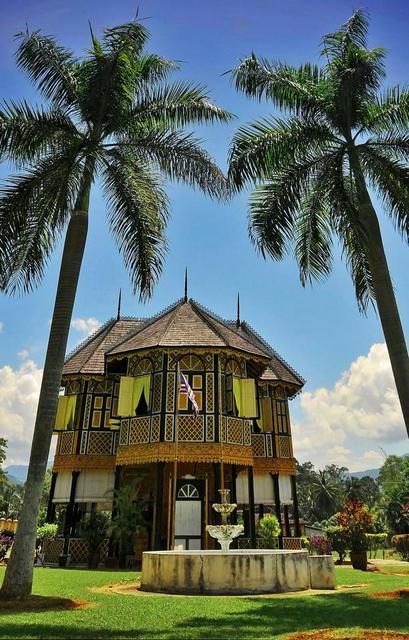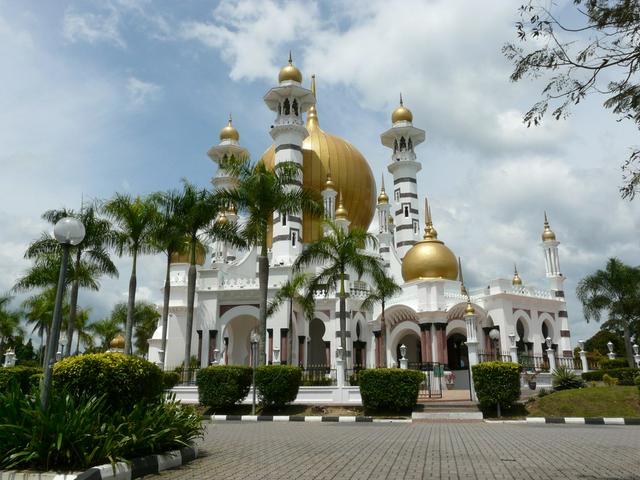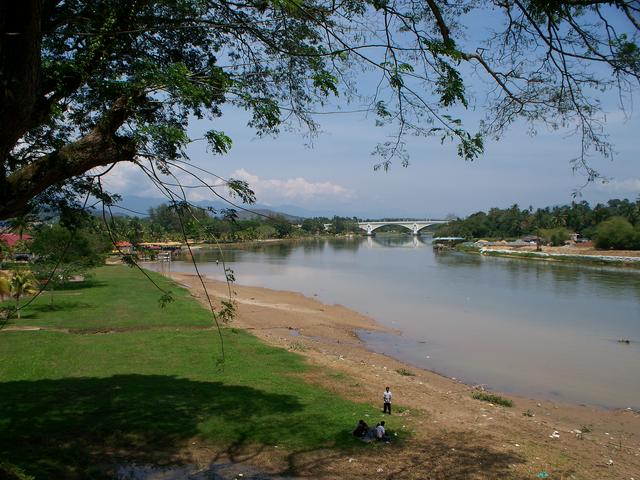Kuala Kangsar is the royal town of Perak.
 It was here that the first rubber tree was planted in the then Malaya, by the English botanist Henry Nicholas Ridley. This rubber tree still stands in the compound of the Kuala Kangsar City Hall (Majlis Perbandaran Kuala Kangsar).
It was here that the first rubber tree was planted in the then Malaya, by the English botanist Henry Nicholas Ridley. This rubber tree still stands in the compound of the Kuala Kangsar City Hall (Majlis Perbandaran Kuala Kangsar).

- Ubudiah Mosque. The beautiful Ubudiah mosque was designed by Arthur Benison Hubback, a government architect who is notably credited for the design of the Ipoh railway station and the Kuala Lumpur railway station. Construction began in 1910 but it was abandoned during World War I. It was also delayed when the then crown prince's elephant walked over and cracked the imported Italian marble floor. The mosque was finally completed in 1919.
- Sultan Azlan Shah Gallery, galeri Sultan Azlan Shah, Bukit Chandan, 33000 (drive straight from the clock tower, the building is just before the Ubudiah Mosque, +60 57775362. Sa-Th 10:00-17:00; F 10:00-12:15,14:45-17:00; Su off. This is a gallery where records and artifacts of the present Sultan, who was also the 9th King of Malaysia, Chief Justice, and an avid hockey player who is also the Vice President of International Hockey federation is kept and exhibited. Adult RM 4; senior citizen, university or college, secondary school RM 2; children RM 1.
- Istana Kenangan, Istana Lama Bukit Chandan, +60 5776 5500. This used to be a royal palace. The museum is closed for renovation and the building cannot be accessed. It is still worth to look at the house from outside though.
- Istana Iskandariah. The Sultan's Palace, Istana Iskandariah is another legacy of British architect serving in the then Malaya. It is a massive marble structure with a series of towers, topped by golden onion domes set among trees and rolling lawns.
- Malay College Kuala Kangsar. One of the premier schools in Malaysia. It is now a full boarding school. It was founded by 4 sultans from the Negeri-negeri Melayu Bersekutu in 1905, as result of their desire to spearhead the future of Malays. They were Sultan Idris (Perak), Sultan Sulaiman (Selangor), Sultan Ahmad (Pahang) dan Yang Dipertuan Besar Mohd Shah (Negeri Sembilan). During the Japanese Occupation in World War II, the school was turned into administration offices and a hospital for the Japanese Imperial Army, who interrogated and subsequently beheaded anyone found to be a traitor. A school once again in the 1950s, it attracted a celebrated crowd - Anthony Burgess taught here. Many buildings date back to as far as 1909, such as the attractive red-roofed Big School. Another prominent feature is said to be the Big Tree, a raintree in front of the East Wing which is considered to be as old as the school itself. Known as Eton of the East, it has produced a good number of Malay leaders and politicians.
- Sultan Abdul Jalil Shah Bridge. Connects the town of Kuala Kangsar to Sayong where village craftsmen produce the Labu Sayong.
- Kuala Kangsar Clock Tower. Right in the middle of the town, which serves as the round-about for traffic management.
- Labu Sayong. Traditional water pitcher (containers) for storing drinking water are a cottage industry in Kampong Sayong. Interestingly, these water containers provide natural referigeration and the water stored are cold when kept overnight in the container. See how they are made by driving to the village.
- Kuala Kangsar Railway Station. A historical and interesting place to visit in this small Royal town. Not many railway stations this old exist in Malaysia these days. The station lies between Pandang Rengas and Sungai Siput.
- Oldest rubber tree in Malaysia. The first rubber tree was planted in 1877 near the Kuala Kangsar District Office. There were nine trees planted and this was the only one which survived. The rubber seeds were brought from Kew Garden in London to Singapore, then over to the mainland to Kuala Kangsar by H.N. Ridley. He was the man responsible for turning Kuala Kangsar into the first rubber industry district in Malaysia. Soon rubber became an important source of income for the country.
Ubudiah Mosque. The beautiful Ubudiah mosque was designed by Arthur Benison Hubback, a government architect who is notably credited for the design of the Ipoh railway station and the Kuala Lumpur railway station. Construction began in 1910 but it was abandoned during World War I. It was also delayed when the then crown prince's elephant walked over and cracked the imported Italian marble floor. The mosque was finally completed in 1919.
Sultan Azlan Shah Gallery, galeri Sultan Azlan Shah, Bukit Chandan, 33000 (drive straight from the clock tower, the building is just before the Ubudiah Mosque, +60 57775362. Sa-Th 10:00-17:00; F 10:00-12:15,14:45-17:00; Su off. This is a gallery where records and artifacts of the present Sultan, who was also the 9th King of Malaysia, Chief Justice, and an avid hockey player who is also the Vice President of International Hockey federation is kept and exhibited. Adult RM 4; senior citizen, university or college, secondary school RM 2; children RM 1.
Istana Kenangan, Istana Lama Bukit Chandan, +60 5776 5500. This used to be a royal palace. The museum is closed for renovation and the building cannot be accessed. It is still worth to look at the house from outside though.
Istana Iskandariah. The Sultan's Palace, Istana Iskandariah is another legacy of British architect serving in the then Malaya. It is a massive marble structure with a series of towers, topped by golden onion domes set among trees and rolling lawns.
Malay College Kuala Kangsar. One of the premier schools in Malaysia. It is now a full boarding school. It was founded by 4 sultans from the Negeri-negeri Melayu Bersekutu in 1905, as result of their desire to spearhead the future of Malays. They were Sultan Idris (Perak), Sultan Sulaiman (Selangor), Sultan Ahmad (Pahang) dan Yang Dipertuan Besar Mohd Shah (Negeri Sembilan). During the Japanese Occupation in World War II, the school was turned into administration offices and a hospital for the Japanese Imperial Army, who interrogated and subsequently beheaded anyone found to be a traitor. A school once again in the 1950s, it attracted a celebrated crowd - Anthony Burgess taught here. Many buildings date back to as far as 1909, such as the attractive red-roofed Big School. Another prominent feature is said to be the Big Tree, a raintree in front of the East Wing which is considered to be as old as the school itself. Known as Eton of the East, it has produced a good number of Malay leaders and politicians.
Sultan Abdul Jalil Shah Bridge. Connects the town of Kuala Kangsar to Sayong where village craftsmen produce the Labu Sayong.
Kuala Kangsar Clock Tower. Right in the middle of the town, which serves as the round-about for traffic management.
Labu Sayong. Traditional water pitcher (containers) for storing drinking water are a cottage industry in Kampong Sayong. Interestingly, these water containers provide natural referigeration and the water stored are cold when kept overnight in the container. See how they are made by driving to the village.
Kuala Kangsar Railway Station. A historical and interesting place to visit in this small Royal town. Not many railway stations this old exist in Malaysia these days. The station lies between Pandang Rengas and Sungai Siput.
Oldest rubber tree in Malaysia. The first rubber tree was planted in 1877 near the Kuala Kangsar District Office. There were nine trees planted and this was the only one which survived. The rubber seeds were brought from Kew Garden in London to Singapore, then over to the mainland to Kuala Kangsar by H.N. Ridley. He was the man responsible for turning Kuala Kangsar into the first rubber industry district in Malaysia. Soon rubber became an important source of income for the country.

- Ulu Kenas Waterfall. Have a family picnic at this waterfall which is in the Ulu Kenas Forest Reserve. Facilities available are basic, and only on weekends the stalls selling food items and snacks are opened. Bring your own food to enjoy your jungle waterfall picnic.
- Try the local speciality: Laksa. Plenty of stalls and restaurants can be found right next to the jetty.
- Ferry ride. Take a ferry ride across Perak River in the passenger ferry boats plying very frequently between the town and Kampong Sayong Tebing. You get a 10-minute ride on the ferry to experience the local lifestyle. It's worth it! RM0.20.
Ulu Kenas Waterfall. Have a family picnic at this waterfall which is in the Ulu Kenas Forest Reserve. Facilities available are basic, and only on weekends the stalls selling food items and snacks are opened. Bring your own food to enjoy your jungle waterfall picnic.
Try the local speciality: Laksa. Plenty of stalls and restaurants can be found right next to the jetty.
Ferry ride. Take a ferry ride across Perak River in the passenger ferry boats plying very frequently between the town and Kampong Sayong Tebing. You get a 10-minute ride on the ferry to experience the local lifestyle. It's worth it! RM0.20.
- A variety of souvenirs from Labu Sayong, handicrafts, mengkuang mats, keris, traditional fish traps, parangs (long knives) and foodstuffs at and around Jalan Tebing, Kuala Kangsar.
- Laksa while available in many parts of Malaysia, with slight variations, one unique feature of the Kuala Kangsar Laksa is the Laksa (the vermicelli, or "meehoon") itself. Almost all the Laksa vendors here serve their "laksa vermicelli" freshly made. Thus, the texture is more savouring compared to the dried vermicelli which are first soaked prior to being served.
- Masak Lemak Ikan Patin a delicious Malay dish, served with rice. The Ikan Patin ( a river fish of the cat fish family) is cooked in coconut milk with herbs, spices and condimums with the formidable "cili api" (Thai pepper). Small eateries along the Tebing of the town serves this dish. Find the jetty for the passenger boat to Sayong and these eateries can never be missed.
Laksa while available in many parts of Malaysia, with slight variations, one unique feature of the Kuala Kangsar Laksa is the Laksa (the vermicelli, or "meehoon") itself. Almost all the Laksa vendors here serve their "laksa vermicelli" freshly made. Thus, the texture is more savouring compared to the dried vermicelli which are first soaked prior to being served.
Masak Lemak Ikan Patin a delicious Malay dish, served with rice. The Ikan Patin ( a river fish of the cat fish family) is cooked in coconut milk with herbs, spices and condimums with the formidable "cili api" (Thai pepper). Small eateries along the Tebing of the town serves this dish. Find the jetty for the passenger boat to Sayong and these eateries can never be missed.
- Jannah. Good Indian restaurant.
Jannah. Good Indian restaurant.
Cendol Kuala Kangsar, which in the local dialect is pronounced as "cendoi."
- The Cuesport Cafe. Tu-Su. --Possibly closed down. No information online about this place-- The first sports cafe in town. The cafe provided 3 table of British pool to play while enjoying light beverages and ice-cream.Located at Bandar Baru Fasa 2 which is beside the Bus Terminal and Taxi Terminal. Ample car park in open space with the neighbourhood of banking such as Maybank, Agro Bank, CIMB and Bank Simpanan Nasional.
The Cuesport Cafe. Tu-Su. --Possibly closed down. No information online about this place-- The first sports cafe in town. The cafe provided 3 table of British pool to play while enjoying light beverages and ice-cream.Located at Bandar Baru Fasa 2 which is beside the Bus Terminal and Taxi Terminal. Ample car park in open space with the neighbourhood of banking such as Maybank, Agro Bank, CIMB and Bank Simpanan Nasional.
- Ipoh
- Cameron Highlands
- Pangkor
- Taiping
